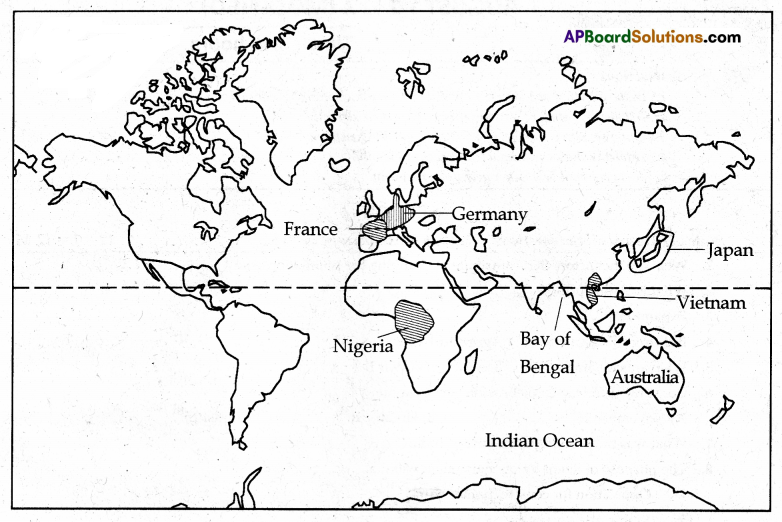Access to a diverse set of AP 10th Class Social Model Papers and AP 10th Class Social Board Model Paper 2023 ensures a well-rounded preparation strategy.
AP 10th Class Social Model Paper 2023 with Solutions
Time: 3.15 hours
Max. Marks: 100
Instructions:
- In the duration of 3 hours, 15 minutes, 15 minutes of time is allotted to read the question paper.
- All answers shall be written in the separate booklet only.
- Question paper consists of 4 Sections and 33 Questions.
- Interna I choice is available in Section IV only.
- Answers shall be written neatly and legibly.
Section – I
12 × 1 = 12 M
Note:
1) Answer all the questions.
2) Each question carries 1 mark
Question 1.
What are called ‘Duns’?
Answer:
The valleys lying between the Lesser Himalayas and Shivalik ranges are called Duns. Eg: Dehradun, Kotti Dun and Path Dun.
Question 2.
Call Center Employee: Service Sector:: Frsherman: …………………. ? ……………………..
Answer:
Agriculture.
Question 3.
Expand A.G.W.
Answer:
Anthropogenic Global Warming.
![]()
Question 4.
What is meant by Sex Ratio?
Answer:
The number of females per 1000 males in a given population.
Question 5.
Mention the most common reasons for males and females to migrate.
Answer:
Employment is the main reason for males and marriage is the main reason for females to migrate.
Question 6.
“We will drown, but we will not move!’ Who wrote these words and to whom?
Answer:
Bara Mahalia wrote these words addressing the then Chief Minister Digvijay Singh of Madhya Pradesh.
Question 7.
What is the name of the last Tsar of Russia?
Answer:
Tsar Nicholas II.
Question 8.
Match the ‘Agent Orange’ with one of the following:
a) Plant Killer.
b) Silent Spring
c) Chipko Movement
Answer:
Plant killer.
Question 9.
Who succeeded Jawaharlal Nehru as Prime Minister?
Answer:
Lal Bahadur Sastry.
Question 10.
Which International Organization is connected with the given logo?

Answer:
UNO – United Nations Organisation
Question 11.
Plot the below information on a bar graph:
Seat Share in 1952 Elections
| Indian NationaI Congress | 364 |
| People’s Democratic Front | 38 |
Answer:
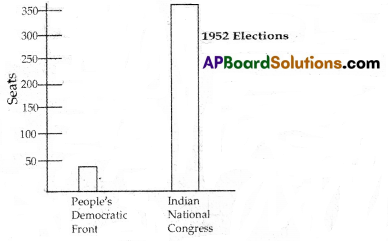
Question 12.
Arrange the following from the West to the East:
Austria, Japan, India, China
Answer:
Austria, India, China, Japan.
![]()
Section – II
8 × 2 = 16 M
Note:
1) Answer all the questions.
2) Each question carries 2 marks.
Question 13.
What is ‘Site’ in view of Settlements?
Answer:
The characteristics of a place like topography, altitude, water characteristics, types of soils, security etc., from natural forces refers to a site.
Question 14.
Comment on the conditions of small farmers in India.
Answer:
- 87% farmers of India are poor having less than 2 hectares of land.
- They are trapped in debt – born in debt, grow in debt, and die in debt.
- They have no other source to earn and develop.
Question 15.
Based on the information given below, write your observations.
Employment in Various Sectors
| Year | Agriculture | Industry | Services |
| 1972-73 | 74% | 11% | 15% |
| 2009-10 | 53% | 22% | 25% |
Answer:
- The table gives information of employment in various sectors in 1972-73 and 2009-10.
- The percentage of workers employed decreased in agriculture and increased both in industry and services from 1972-73 to 2009-10.
- Still agriculture is providing major portion of employment.
Question 16.
Observe the given map:
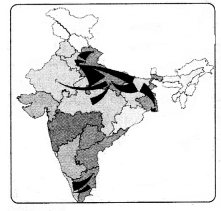
Qn. : Name any four states in which migration takes place.
Answer:
Himachal Pradesh, Uttarakhand, Uttar Pradesh, Biliar.
![]()
Question 17.
Write any two benefits of Lok Adalat.
Answer:
- There is no court fee,
- Speedy trail of disputes.
- Procedural flexibility.
- The parties can directly interact with the judge.
Question 18.
What is meant by Coalition Government?
Answer:
Coalition government: The type of government in which two or more than two political parties come together to form a single government when a clear majority is not achieved by any party.
Ex:
- National Democratic Alliance (NDA).
- United Progressive Alliance (UPA)
Question 19.
How many States and Union Territories are there in India today?
Answer:
There are 28 States and 8 Union Territories.
Question 20.
Appreciate the Meira Paibi Movement’.
Answer:
- Meira Paihi (in Meitei language) literally can be translated as ‘torch bearers’.
- It became a movement of human rights with the massive deployment of Indian armed forces to counter the armed movement in the early 1980s.
- This resulted in frequent military operations and human rights violations. The Meira Paibi responded instantly with protest demonstrations.
- The Meira Paibi took out patrolling the streets at night.
- Women of every leikai or ward of every town and village participated in the daily patrolling.
- Bearing no weapons but only the bamboo and rag kerosene torches, the patrolling carried out.
- These are not activists or politically inclined women, Meira Paibi group has also been demanding that AFSPA be revoked.
Section – III
8 × 4 = 32 M
Note:
1) Answer all the questions.
2) Each question carries 4 marks.
Question 21.
Explain the uses of Public Distribution System.
Answer:
Environment’s Source Function:
The potential of the environment to provide the natural resources.
Environment’s Sink Function:
The potential of the environment to absorb and render harmless waste and pollution.
Question 22.
What are the immediate causes of the First and Second World Wars?
Answer:
- Urban areas have facilities like good educational institutions, good hospitals, factories and industries to provide good employment opportunities and recreational facilities like amusement parks, cinema malls, theme parks etc.
- Rural people do not have these facilities.
- So rural people migrate to urban areas in search of better employment, income and health facilities.
- The rural people also migrate to urban areas in search of better education to their children.
![]()
Question 23.
What were the difficulties faced in conducting of First General Elections in India?
Fertility Rate in India 1961 – 2011
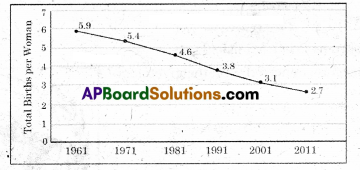
Answer:
- The graph depicts the trend of fertility rate between 1961 – 2011.
- The fertility rate is the number of children that is likely to be born to a woman if she were to live to the end of her childbearing year and bear children in accordance with the current pattern.
- The graph is showing decline in fertility rate from 1961 to 2011 from 5.9 in 1961 to 2.7 in 2011.
- The decline means the couples are deciding to have fewer children.
- This is a good sign of family planning and control of population.
- The family decides the number of children they want depending on security, opportunity for children, and social norms.
- However, in long run, this family planning may have adverse effect on economy with no young generation and increased old people.
Question 24.
Observe the given map and answer the following questions.
Answer:
- National Food Security Act legalizes people’s right to food. It is applicable to 2/3’ of the population of India.
- PDS ensures availability of food grains to the poor at subsidised rates.
- Antyodaya cardholders are entitled to get 35 kgs of food grains (rice or wheat) per month per family.
- Every person of low-income families is entitled to 5 kilograms of food grains per month at subsidised rates.
- 75% of people living in rural areas purchases food grains through PDS. 50% of urban population purchase food grains through PDS.
- PDS helps in maintaining nutrition status of the people.
Question 25.
Explain Environment’s Source Function and Sink Function.
Answer:
Immediate causes: The murder of Archduke Ferdinand of Austria by a Serbian was the immediate cause for World War – I. The immediate cause for World War – II was Flitler’s invasion of Poland for refusing to hand over Danzing port to Germany.
Question 26.
Why are the people migrating from rural areas to urban areas?
Answer:
- Conducting the first general elections was difficult due to various reasons.
- Most of the people were illiterate.
- It was difficult for them to indicate their choice.
- In some areas women were not given an independent identity.
- It was difficult to make electoral rolls in such cases.
- The Election Commission came up with a novel idea to solve these problems.
- It allotted symbols from everyday life to various political parties and candidates.
- It arranged each candidate a separate ballot box with the symbol stuck outside. Thus, the first elections became difficult due to various reasons, but they were conducted successfully by the Election Commission.
Question 27.
Write your observations from the given graph.
(i) Who occupied more region?
(ii) Name the river in the map.

Answer:
i) Hausa-Fulani people.
ii) River Niger.
![]()
Question 28.
The twentieth century is called “The Age of Extremes”. Why?
Answer:
The 20th century is called the Age of Extremes. The reasons are:
- The two World Wars occurred in this age.
- The world saw the Great Depression in the same period.
- Scientific knowledge rose to new heights.
- Women got right to vote during this period.
Section -IV
5 x 8=40 M
Note:
1) Answer all the questions.
2) Each question carries 8 marks.
3) Each question has internal choice.
4) In question no.33, both A and B (India map and World map) should be answered separately.
Question 29.
(a) What are the differences between Eastern Coastal Plain and Western Coastal Plain?
(OR)
(b) In what ways was the emergency period a setback to Indian democracy?
Answer:
a)
| The Eastern coastal plains | The Western coastal plains |
| 1. The Eastern coastal plain lies between the Eastern Chats and the Bay of Bengal. | 1. The Western coastal plain lies between the Western Ghats and the Arabian Sea. |
| 2. It stretches from Mahanadi in Odisha to Cauvery delta in Tamil Nadu. | 2. It starts at the Rami of Kutch and ends at Kanyakumari. |
| 3. These are wide and have large surface structure. | 3. These are narrower than the Eastern coastal plains. |
| 4. These plains are formed by rivers Mahanadi, Godavari, Krishna and the Cauvery. | 4. These plains are uneven and broken by hilly terrain. |
| 5. These plains are very fertile. | 5. These plains are less fertile. |
| 6. These plains can be divided into three parts. a) Utkal coast b) Circar coast c) CoramandaL coast |
6. These plains can be divided into three parts. a) Konkan coast b) Canara coast c) Malabar coast |
| 7. These plains are agriculturally developed. | 7. These plains are not agriculturally developed. |
| 8. Lakes like Chilka in Odisha and Kolleru and Pulicat in A.P are other important features of these plains. | 8. There are no such lakes ¡n these plains. |
(OR)
b)
- the government passed a series of laws which violated civil rights in the name of maintaining order.
- Democracy was put on hold. The government resorted to repressive measures, claiming that it was necessary to control law and order in the country.
- Many of the fundamental rights were suspended.
- There were instances of arbitrary detention, torture, and other violations of civil liberties.
- Demolition of slums and forced sterilization in the name of population control became very unpopular. .
- In the absence of civic freedom people were unable to express their discontent and the government therefore could not take corrective measures.
- The 42nd Constitutional Amendment done during emergency period actually weakened the democratic fabric of this country.
Question 30.
(a) Explain the impact of Globalization on India.
(OR)
(b) Explain the relations between India and China.
Answer:
a)
- The impact of globalisation in India is not uniform. .
- It has benefited rich consumers.
- Certain services connected to technology have expanded.
- Some new jobs are created.
- Some large Indian companies have grown as MNCs
- Most of the small producers and workers are not happy with globalisation as their employment and rights are eroded.
- The consumers enjoyed a variety range of choices due to globalisation.
(OR)
b)
- India and China have conflicts between them and there are no cordial bilateral relations at present.
- The border dispute, the river water dispute, the Tibet issue made the relations wider and worse.
- Though India extended its friendly hand in supporting for permanent seat to China in the Security Council and in other issues China is creating problems to India.
- China is supporting Pakistan on Kashmir issue. Everytime China is opposing India supporting extremes of Pakistan and raising unrest in India.
- China invaded India in October 1962 violating the peace treaty it signed with India.
- India and China are the rising powers of the world.
- Cordial relations between them help to grow strong.
- It is happy to hear that India and China troops disengaged at LAC (Line of Actual Control) on 8th September 2022 with mutual consent.
![]()
Question 31.
a) Plot the information given in the following pie graphs in a table and write your observation.

(OR)
b) Observe the graph and answer the following questions:
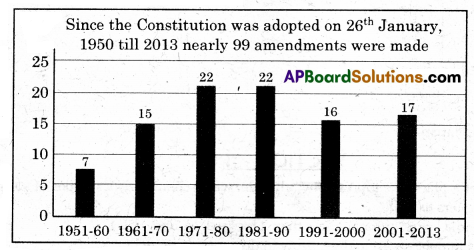
i) How many amendments were made till 2013?
ii) In which decades were more amendments made?
iii) In which year did the Constitution come into force?
iv) Show the particulars given in the graph in a tabular form.
Answer:

- The pie charts depict the shares of employment during 1972-73 and 2009-2010 and shares of three sectors – [agriculture, service and industry] in GDP during 1972-73 and 2009-2010.
- The shares of employment of agriculture was 74% and service sector was 15% and industrial sector was 11% in 1972-73.
- By 2009-2010, the scenerio changed. The service sector and industrial sector provided more employment compared to 1972-73. The share of employment of agricultural sector decreased to 53% in 2009-2010 from 74% in 2009-2010. However, the agricultural sector is providing more employment compared to service and industrial sector.
- In 1972-73 agriculture was contributing 43% to GDP and service sector 35% and industrial sector 22% of GDP.
- By the 2009-2010, the percentages of the sectors changed compared to 1972-73.
- In 1972-73, the share of agriculture in GDP was 43%, whereas it declined to 17% in 2009-2010.
- In ‘72-’73, the share of industry was 22% in GDP whereas it raised to 26% by 2009-2010.
- In ‘72-73, the share of service sector was 25% in GDP. It raised to 57% by 2009-2010.
- The raise of shares of service and industrial sectors signifies healthy growth of Indian economy.
(OR)
b)
- 99 amendments.
- 1971-80 and 1981-90.
- 1950.
| Period of time | Number of amendments made to the Constitution |
| 1951-1960 | 7 |
| 1961’-1970 | 15 |
| 1971-1980 | 22 |
| 1981-1990 | 22 |
| 1991-2000 | 16 |
| 2001-2013 | 17 |
Question 32.
a) Increasing urbanization is not just about greater opportunities or people and economy. It also results in many problems – Comment.
(OR)
b) “War is always destructive”. Comment.
Answer:
a)
- Urbanisation is defined as movement of people from rural area to urban area. Generally people migrate for better living opportunities which lead to increase ¡ri population size in urban areas.
- Urbanisation provides opportunities of good living with jobs and increased financial facilities.
- But, urbanisation results in many problems.
- The slums increase leading to pollution.
- The standard of living decreases.
- Traffic congestion increases.
- The cost of living increases leading to high educational fees, medical expenditures, high rents.
- Social unrest grows with increased crime rate.
(OR)
b) Yes. War is expensive and deeply affects the peoples lives. The example of two World Wars is before us.
- Millions of people – both soldiers and ordinary citizens lost their lives. Of those who did come home from the war, were injured physically or struggled mentally
- The children and women bear the most difficult atrocities of their lives.
- Even the winners of war suffered.
- Inflation and the rise in prices is the most common immediate effect of war.
- There have been numerous examples where the country is seen to suffer through health hazards, epidemics and needs a tough contest to battle the same.
- History proves that war never resolves any problem. In fact it breeds more economical and soda problems.
- No one won the last war and no one will win the next.
![]()
Question 33.
A) Locate the following in the given outline map of India. .
a)
i) Vindhya Ranges
ii) Krishna River
iii) Sikkim
iv) Thar Desert
(OR)
b)
i) Aravalis
ii) Godavari River .
iii) Andaman & Nicobar Islands
iv) Tropic of Cancer
Answer:
A)
a)
i) Vindhya Ranges
ii) Krishna River
iii) Sikkim
iv) Thar Desert
(OR)
b)
i) Aravalis
ii) Godavari River
iii) Andaman & Nicobar Islands
iv) Tropic of Cancer
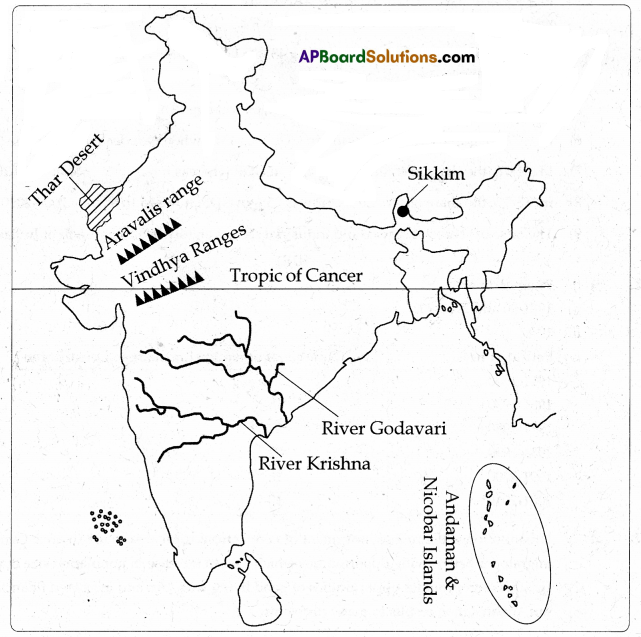
B) Locate the following in the given outline map of World.
a)
i) Bay of Bengal
ii) Japan
iii) Australia
iv) Germany
(OR)
b)
i) Indian Ocean
ii) Nigeria
iii) Vietnam
iv) France
Answer:
B)
a) i) Bay of Bengal
ii) Japan
iii) Australia
iv) Germany.
(OR) .
b)
i) Indian Ocean
ii) Nigeria
iii) Vietnam
iv) France
